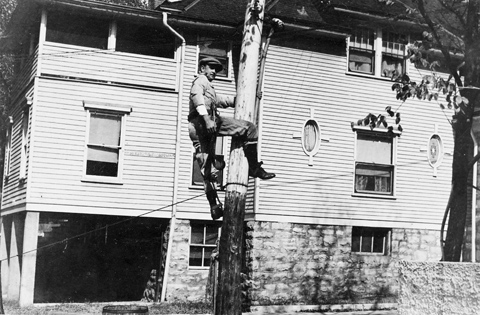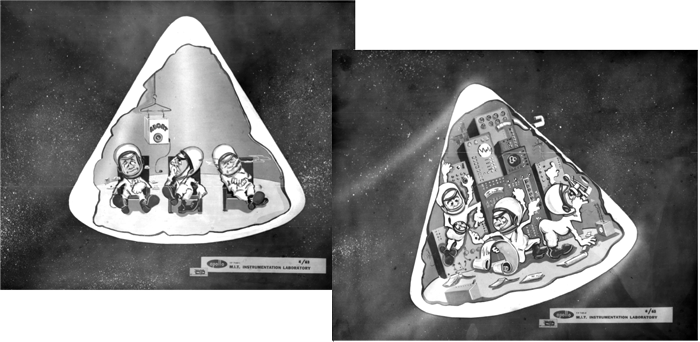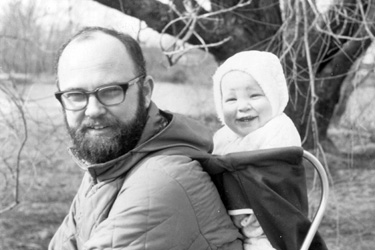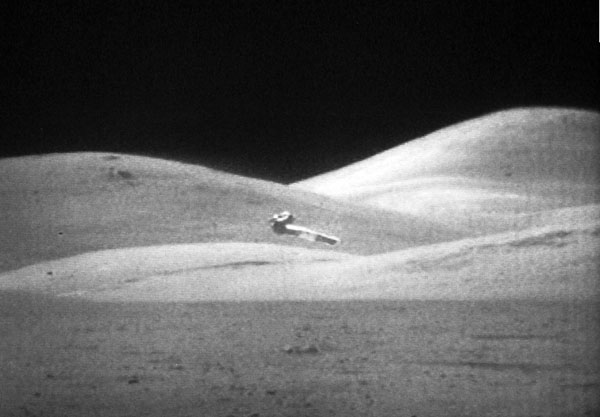
Doc Draper in the navigation simulator on the
roof of 75 Cambridge Parkway. [CSDL]
“Doc, can you design a guidance system that will take men to the moon and back safely?”
“Yes.”
“Well, when will it be ready?”
“It will be ready when you need it, Mr. Webb.”
“Well, how will I know that it'll work?”
“I'll go along with it.”
[p. 35]

As town electrician. [CSDL]

Flight training, Brooks Field, Texas. [CSDL]
Doc Draper hitchhiked across the country in 1922 with an undergraduate degree in psychology from Stanford University and a background that included a stint as the municipal electrician in his home town of Windsor, Missouri. He came with friends to investigate Harvard University for graduate school but he stopped at MIT on his way up Massachusetts Avenue and never made it to Harvard Square. [p. 34]

Battle of Santa Cruz, October 26, 1942. USS South Dakota in distance, USS Enterprise foreground.

Mark 14 Gunsight.
The gunsight was called the Mark 14. The number 14 was deceptive, chosen to confer respectability on what was truly a Mark 1. Doc said he chose the number to commemorate his infamous practice of standing on 14 at blackjack. “If the gunsight could overcome the handicap of being named Mark 14, it would do well in any job to which it might be assigned.” [p. 38]
The newly launched battlewagon South Dakota, identified in the press for secrecy as Battleship X, went to sea with Mark 14s on its 20-mm and 40-mm antiaircraft guns and in October 1942 took part in the battle of Santa Cruz, near Guadalcanal. The ship bagged 32 attacking aircraft. Maybe it was 26, but the main thing was that the ship, and the aircraft carrier it was protecting, survived the attack. [p. 38]

Installation of the SPIRE inertial measurement unit in MIT's B-29 bomber prior to the first cross-country flight guided by an inertial navigation system.[CSDL]
In 1953 Doc's team installed their first entirely self-contained inertial navigation system in MIT's B-29 bomber and tested it by flying automatically from Hanscom Field near Boston to Los Angeles. Eleven men were onboard. Pilot Chip Collins would have preferred otherwise; it was a test flight with an unproven machine controlling the aircraft. “When you run a house of ill repute you have to take on all comers,” was Doc's retort. [p. 39]

Doc explaining the second generation SPIRE system to reporter Erik Sevareid [CSDL]

The Apollo inertial measurement unit (IMU), diameter about one foot. Inner and outer gimbals are at left and right. Middle gimbal top and bottom. [author's photo of CSDL exhibit]
“You need to have instruments for geometry the same way you have a watch for time.” [p. 37]
So it was that deep inside an Apollo spacecraft, surrounded by electronic assemblies, suspended inside a spherical case, was an object that never budged from its fixed relationship to the stars, no matter how the spacecraft maneuvered. [p. 42]
(Meanwhile)

My parents thought I looked like General Eisenhower, who was much in the news when I was an infant. On my first birthday, the month after
D-Day, they took my picture in a garrison cap with four paper stars pinned to it. [p. 9]

Each “chip” contained two logical devices called triple input NOR (not or) gates. Such a gate, if any of its three input is a one, outputs a zero, otherwise a one — the two values
indicated by voltage levels. In high school, after learning about truth tables, James Chambers [left in photo] and I had experimented with similar devices composed of relays mounted on a piece of plywood. [p. 64]

I had heard a few things about the Instrumentation Lab, enough to be daunted by the prospect of walking in and
asking for a job. On the other hand, what did I have to lose? If my self-esteem had been higher I might have hesitated longer. [p. 18]
The Apollo Mission
From the Earth to the Moon
From the Moon to the Earth

From the Earth to the Moon
From the Moon to the Earth

The antidote to the melancholy of having to work for a living was a document that described the steps by which an Apollo mission would reach the surface of the Moon. [p. 20]

George Cherry, project manager for the LM software, who originated the guidance equation for the lunar landing, and hired me. This is the only photo of camera-shy Cherry in Draper Lab files. [CSDL]

Allan Klumpp, who turned Cherry's equation into a fleshed-out system, and guided me as I programmed it for the flight computer. Photo taken at an anti-war demonstration on Boston Common. [DE]
One day during my second week I was talking to George Cherry when a gangling, crew-cut person wandered by, stopped, scratched his back on the door jamb, and gave me a quizzical look. George made the introductions and I met the man who would be my mentor and teammate for the next six years. Allan Klumpp was working on the guidance algorithm that would control the LM during the maneuver at the apex of the whole mission, the descent from lunar orbit to the lunar surface.
How do you land on the Moon? Klumpp! But it was a big job and Allan needed help. [p. 23-24]

The Apollo Guidance Computer (AGC) and it's display and keyboard unit (DSKY). DSKY markings are unlike flight units. [CSDL]

Rear view of the computer showing modules that contain the flight computer program in the form of wire-rope memory. [CSDL]

The computer program in this listing would be encoded in six modules of wire-rope memory. [DE]
The computer program for the first LM mission was called Sunburst. For flight it would be encoded in a very reliable form of memory that resembled a rope woven from thin copper wire, but we knew it best on paper. It was the 1960s. We had no terminals of any kind, no DECs, no VAXes, no PCs, no Macs — much less the menagerie of devices that exist as I write this. What we gazed at when we wanted to think about the mission and the computer program was paper. [p. 43]

Dick Battin [CSDL]

Hal Laning [CSDL]
For us who were programming the guidance computer, Hal Laning and Dick Battin were the poles between which we were held in tension. Laning represented the practical side: the languages we used and the real-time operation of the computer as it coped with many jobs and tasks at essentially the same time. Battin personified the legacy of Kepler and Newton, the equations that it was our job to embed in the context conceived by Laning. [p. 120]

The crew-interface question,
as seen in 1963. [CSDL]

The LM cockpit during the Visibility Phase of the lunar landing. [DE]
Astronauts may have begun as “spam in a can” — Chuck Yeager's derisive phrase for the original astronauts, as reported by Tom Wolfe — but that was not going to be the case on an Apollo Moon mission. Human input was essential and the guidance system had to be designed for it. [p. 25]

Core rope simulator is in rack at right. The AGC itself is concealed in the next rack, which has a DSKY mounted on the front. [CSDL]

Beckman analog computer. Note the plug-boards used to program the device, and the strip-chart machine for plotting various parameters in real time. [CSDL]

LM cockpit on the third floor, directly above the hybrid lab. Console at left controlled the unsuccessful visual displays. [CSDL]
The hybrid simulator was important because we could control a mission just as the astronauts would, using the computer's display and keyboard. At first we used the DSKY mounted on an equipment rack in the lab. Later we flew lunar landings from the LM cockpit — constructed from plywood but fully equipped with keyboard, eight-ball, displays, switches and control sticks — on the third floor directly above. [p. 85]

The Author [DD]

Dana Densmore [DE]
One day we walked around town with my Pentax camera. The pictures show Dana in a toggle coat, me in a corduroy jacket with long hair, mustache and wire rims — my look less hippie or beatnik, perhaps, than Bloomsbury. [p. 108]

The LMS (LM Mission Simulator) at KSC, painted green to distinguish it from the Command Module simulator beyond. The LM cockpit is inside the irregular cluster of boxes in the foreground. The canopy-like structure behind it is the L&A (landing and ascent), which provided out the window views when lunar landings were simulated. [NASA] Inset, Bob Pearson, known as “Mr. LMS.” [DE]

Astronaut John Young called it “the great train wreck.” It looked haphazard from the outside because the focus of all the apparatus was the spacecraft cockpit that was somewhere deep inside the heap. [p. 178]

Deputy Director Ralph Ragan [CSDL]

Associate Director Dave Hoag [CSDL]

Associate Director Eldon Hall [CSDL]

Associate Director Norm Sears [CSDL]
Managers there were, but in the tradition of Doc Draper they tried not to get in the way. Really they had no choice but to trust us, if we were to accomplish the goal at all. [p. 97]
Apollo 14

First row, Vince Megna, Doc Draper, the author, Dave Moore, Tony Cook; and, second row, Phil Felleman, Larry Berman, Allan Klumpp, Bob Werner, Robert Lones, and Sam Drake. Also involved but not present for this photo were Steve Copps, Romilly Gilbert, Ken Goodwin, Bruce McCoy, Russ Larson and Peter Volante. [CSDL]

From left, Larry Berman, Sam Drake, Peter Volante, Bruce McCoy, and the author, in the classroom, with listings of LUMINARY and COLOSSUS. [CSDL]

Edgar Mitchell and Alan Shepard, who trusted us. [NASA]
If you consider the development, simulation, and refinement together, not forgetting the salesmanship of Russ Larson in Houston, [Apollo 14] was very much a team effort and a smooth one at that. [p. 263-264]

The press grandstand at the launch of Apollo 15, July 26, 1971. [DE]

In the grandstand Doc Draper, in a tropical suit and bow tie, worked the house, paying special attention to Mary Bubb, then a statuesque fifty, a reporter who had for many years covered spaceflight for Fairchild Publications. As she did for every launch, Bubb wore a hat that translated the mission patch into three dimensions — in this case chevrons of red, white and blue elevated on dowels above a gray lunar dome. [p. 274]

Hugh Blair-Smith and his daughter. [HBS]

Dan Lickly and Margaret Hamilton, successive chiefs of the software group. [DE]

Peter Adler aboard MS Jugoslavija near Dubrovnik, September 1971. [DE]

Joan and Charlie Jones, Marjorie Shepatin, and the author. [DE]

Jimmy the Flea at the Block Island Inn. From left, Lenny Kaye, Tim White, Ed Finney, Patrick O'Connor, Robert Palmer, Steve Krevsky, and the author. [DE]
Lenny Kaye Mayor Kevin White

A break in a 40-inch water main at the corner of Beacon and Charles Streets, June 4, 1971. [Roland Oxton for the Boston Record-American]
It was a Lenny Kaye caper. The band was named, he said, after “the justly famous Jimmy the Flea of Pawnee-on-the-Shawnee, Pennsylvania.” Two of its members already had entomological backgrounds; guitarist Ed Finney from Memphis, and Bob Palmer (who later wrote about rock-and-roll for the New York Times), on clarinet and Sock-Em hammer, were from a band called The Insect Trust. Steve Krevsky on drums, Patrick O'Connor, bass, Tim White, harp, Lenny on guitars, and yours truly on
conga drum, rounded out the septet. [p. 277]
White had a gift for this sort of interaction. Someone shouted, “Take off his pants,” but White's gambit worked. [p. 277]

Frame from video recorded by the camera on the lunar rover, late in the surface EVA by astronauts Gene Cernan and Jack Schmitt. [NASA]
For just a moment serious people had entertained the possibility that we had made contact with an alien civilization. Apollo may have been an epochal accomplishment, I thought, but it was only the rehearsal for a great deal more. [p. 307]